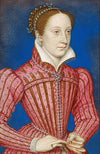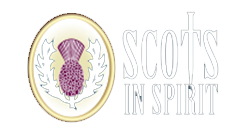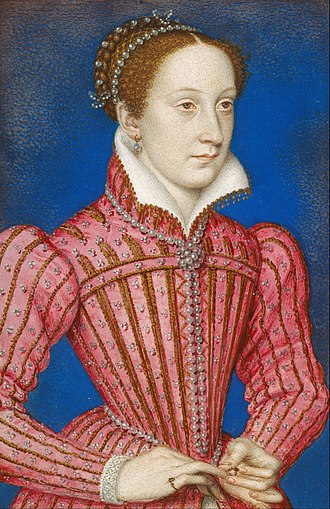
Today, 13 May, is the anniversary of the Battle of Langside in 1568, when forces loyal to Mary Queen of Scots were defeated by forces acting on behalf of her infant son and led by her half brother. This strange-seeming situation was brought about by the convoluted politics of the day, inextricably linked to the struggle between Catholics and Protestants. The battle marked the end of Mary’s reign.
Mary acceded to the Scottish throne in 1542 as a 6-day-old infant. Her mother sent her to be educated at the French court, where she married the Dauphin in 1558. He became King of France in 1559 but died in 1560 and Mary returned to Scotland to finally take up her rule in 1561. She married her English-born but Catholic half-cousin Henry Stuart, Lord Darnley in 1565, causing dissension amongst Protestant Scottish nobility including Mary’s illegitimate half-brother James Stewart, the Earl of Moray.
Mary and Darnley’s son James was born in 1566 but their marriage was under strain. In 1567, Darnley was murdered in an explosion. Many were suspected, including Mary herself; James Hepburn, Earl of Bothwell was finally tried but acquitted. A week later, Bothwell convinced a large number of lords and bishops to sign a bond supporting his aim to marry Mary; and on 24 April 1567 he abducted her. There is some question as to whether she went willingly or not, but in any case they were married (under Protestant rites) on 15 May. The marriage was very unpopular - Catholics considered it unlawful due to the Protestant rites and Bothwell’s divorce from his first wife; and both sides were shocked at her marrying the man accused of Darnley’s murder.
A confederation of Scottish Lords imprisoned Mary in Loch Leven Castle in mid-July and on 24 July she was forced to abdicate in favour of her one-year-old son James. Her half-brother the Earl of Moray was made Regent and Bothwell exiled.
Mary escaped from Loch Leven Castle on 2 May 1568, aided by George Douglas, brother of Sir William Douglas who owned the castle. Determined to assert her rights as Queen she raised a 6000-strong army which then marched for Dunbarton Castle to await further reinforcements. However, on 13 May they were met by Moray's forces at Langside, a small village south of Glasgow, and heavily defeated. Mary fled to England, never returning to Scotland.
Note: Image is a portrait of Mary Queen of Scots by Francois Clouet.




